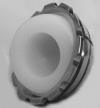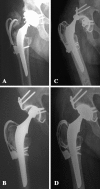The use of a cemented dual mobility socket to treat recurrent dislocation
- PMID: 20532718
- PMCID: PMC2974879
- DOI: 10.1007/s11999-010-1404-7
The use of a cemented dual mobility socket to treat recurrent dislocation
Abstract
Background: The treatment of recurrent dislocation after total hip arthroplasty remains challenging. Dual mobility sockets have been associated with a low rate of dislocation but it is not known whether they are useful for treating recurrent dislocation.
Questions/purposes: We therefore asked whether a cemented dual mobility socket would (1) restore hip stability following recurrent dislocation; (2) provide a pain-free and mobile hip; and (3) show durable radiographic fixation.
Methods: We retrospectively reviewed 51 patients treated with a cemented dual mobility socket for recurrent dislocation after total hip arthroplasty between August 2002 and June 2005. The mean age at the time of the index procedure of was 71.3 years. Of the 51 patients, 47 have had complete clinical and radiographic evaluation data at a mean followup of 51.4 months (range, 25-76.3 months).
Results: The cemented dual mobility socket restored complete stability of the hip in 45 of the 47 patients (96%). The mean Merle d'Aubigné hip score was 16 ± 2 at the latest followup. Radiographic analysis revealed no or radiolucent lines less than 1 mm thick located in a single acetabular zone in 43 of 47 hips (91.5%). The cumulative survival rate of the acetabular component at 72 months using revision for dislocation and/or mechanical failure as the end point was 96% ± 4% (95% confidence interval, 90%-100%).
Conclusions: A cemented dual mobility socket was able to restore hip stability in 96% of recurrent dislocating hips. However, longer-term followup is needed to ensure that dislocation and loosening rates will not increase.
Figures



Similar articles
-
Five to thirteen year results of a cemented dual mobility socket to treat recurrent dislocation.Int Orthop. 2017 Mar;41(3):513-519. doi: 10.1007/s00264-016-3343-8. Epub 2016 Nov 26. Int Orthop. 2017. PMID: 27889840
-
Reconstruction of the Shallow Acetabulum With a Combination of Autologous Bulk and Impaction Bone Grafting Fixed by Cement.Clin Orthop Relat Res. 2017 Feb;475(2):387-395. doi: 10.1007/s11999-016-5107-6. Clin Orthop Relat Res. 2017. PMID: 27837399 Free PMC article.
-
Constrained liner in neurologic or cognitively impaired patients undergoing primary THA.Clin Orthop Relat Res. 2010 Dec;468(12):3255-62. doi: 10.1007/s11999-010-1340-6. Clin Orthop Relat Res. 2010. PMID: 20376709 Free PMC article.
-
Dissociation and Intrapelvic Entrapment of a Dual-mobility Polyethylene Component.Clin Orthop Relat Res. 2016 Apr;474(4):1072-6. doi: 10.1007/s11999-015-4381-z. Epub 2015 Jun 19. Clin Orthop Relat Res. 2016. PMID: 26088765 Free PMC article. Review.
-
Risk factors and modes of failure in the modern dual mobility implant. A systematic review and meta-analysis.BMC Musculoskelet Disord. 2021 Jun 14;22(1):541. doi: 10.1186/s12891-021-04404-4. BMC Musculoskelet Disord. 2021. PMID: 34126990 Free PMC article.
Cited by
-
Outcomes of dual-mobility acetabular cup for instability in primary and revision total hip arthroplasty.J Orthop Traumatol. 2015 Mar;16(1):9-13. doi: 10.1007/s10195-014-0324-9. Epub 2014 Oct 21. J Orthop Traumatol. 2015. PMID: 25330736 Free PMC article.
-
Laser Sintering Approaches for Bone Tissue Engineering.Polymers (Basel). 2022 Jun 9;14(12):2336. doi: 10.3390/polym14122336. Polymers (Basel). 2022. PMID: 35745911 Free PMC article. Review.
-
Dual mobility for total hip arthroplasty revision surgery: A systematic review and metanalysis.SICOT J. 2021;7:18. doi: 10.1051/sicotj/2021015. Epub 2021 Mar 22. SICOT J. 2021. PMID: 33749588 Free PMC article.
-
Cementing a Monoblock Dual-Mobility Implant into a Fully Porous Cup in Revision Total Hip Arthroplasty to Address Hip Instability: Surgical Technique.JBJS Essent Surg Tech. 2023 Nov 22;13(4):e22.00058. doi: 10.2106/JBJS.ST.22.00058. eCollection 2023 Oct-Dec. JBJS Essent Surg Tech. 2023. PMID: 38357466 Free PMC article.
-
Intraprosthetic dislocation: a potentially serious complication of dual mobility acetabular cups.Skeletal Radiol. 2014 Jul;43(7):1013-6. doi: 10.1007/s00256-014-1824-7. Epub 2014 Feb 14. Skeletal Radiol. 2014. PMID: 24522771
References
-
- Adam P, Farizon F, Fessy MH. Dual articulation retentive acetabular liners and wear: surface analysis of 40 retrieved polyethylene implants [in French] Rev Chir Orthop. 2005;91:627–636. - PubMed
-
- Aubriot J, Lesimple P, Leclercq S. Study of Bousquet’s non-cemented acetabular implant in 100 hybrid total hip prostheses (Charnley type cemented femoral component). Average 5-year follow-up [in French] Acta Orthop Belg. 1993;59((Suppl 1)):267–271. - PubMed
-
- Barrack RL, Mulroy RD, Harris WH. Improved cementing techniques and femoral component loosening in young patients with hip arthroplasty. A 12-year radiographic review. J Bone Joint Surg Br. 1992;74:385–389. - PubMed
MeSH terms
Substances
LinkOut - more resources
Full Text Sources
Medical

